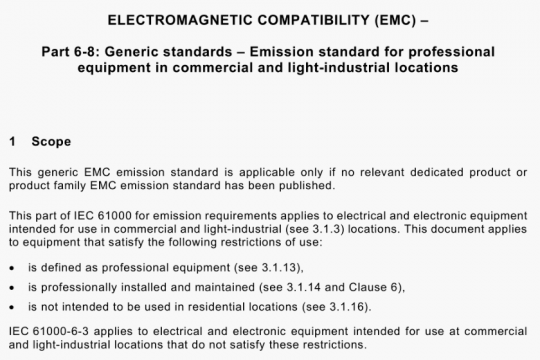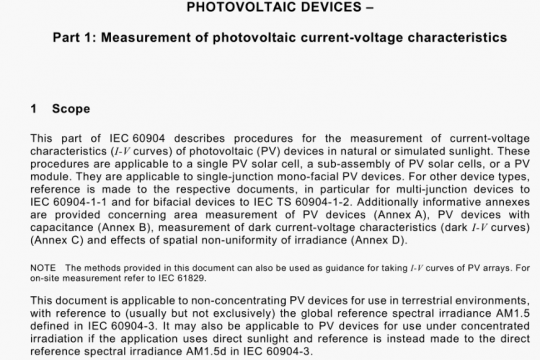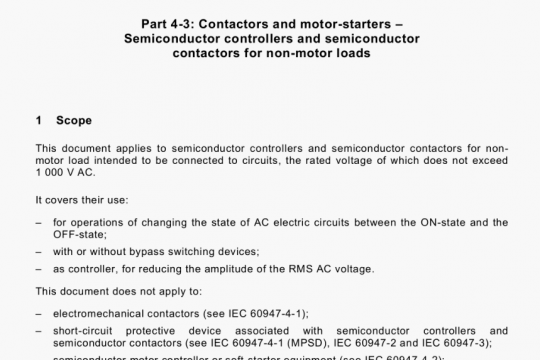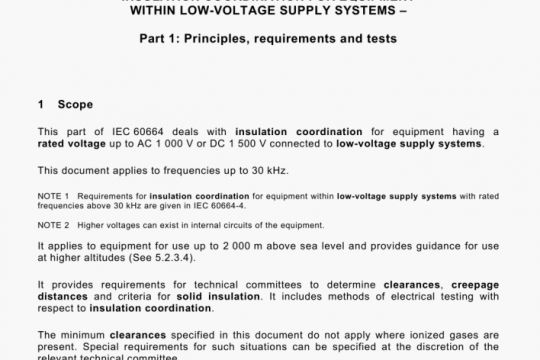IEC/TS 62548-2013 pdf free download
IEC/TS 62548-2013 pdf free download.Photovoltaic (PV) arrays – Design requirements.
5.1.4 Use of PCE with multiple d.c. inputs
5.1.4.1 General
PV arrays are often connected to PCEs with multiple d.c. inputs. Refer to Figures 5 and 6. If multiple d.c. inputs are in use, overcurrent protection and cable sizing within the various sections of the PV array(s) are critically dependent on the limiting of any backfeed currents (i.e. currents from the PCE out into the array) provided by the input circuits of the PCE.
5.1.4.2 PCEs with separate maximum power point tracking (MPPT) inputs
Where a PCEs input circuits provide separate maximum power point tracking inputs, the overcurrent protection of the section of the array connected to those inputs shall take into account any backfeed current as required to be specified by IEC 62109-1.
Each PV section connected to an input (refer to Figure 5) may be treated for the purposes of this Technical Specification as a separate PV array. Each PV array shall have a switchdisconnector to provide isolation of the inverter. The provisions of multiple switchdisconnectors in 7.4,1.3 apply and a warning sign as required in 10.5.2 shall be provided.
5.1.4.3 PCEs with multiple Inputs internally connected together in the PCE
Where a PCE’s multiple input circuits are internally paralleled onto a common d.c. bus, each PV section connected to one of those inputs (refer to Figure 6) shall be treated for the purposes of this Technical Specification as a sub-array and all the PV sections combined shall be classified as the complete PV array. Each PV sub-array shall have a switchdisconnector to provide isolation of the inverter. The provisions of multiple switchdisconnectors in 7.4.1.3 apply and a warning sign as required in 10.5.2 shall also be provided.
5.1.5 Series-parallel configuration
All PV strings within a PV array connected in parallel shall be of the same technology and have the same number of series connected PV modules (see Figure 2 to Figure 4). In addition, all PV modules in parallel within the PV array shall have similar rated electrical characteristics including short circuit current, open circuit voltage, maximum power current, maximum power voltage and rated power (all at STC).
This is a design issue which needs to be considered by the project implementer, particularly when replacing modules or modifying an existing system.
5.1.6 Batteries In systems
Batteries in PV systems can be a source of high prospective fault currents and should have fault current protection installed. The location of fault current protection related to battery systems is generally between the battery and charge controller and as close as practical to the battery. This protection can be used to provide overcurrent protection for PV array cables provided the PV array cable is rated to withstand the same current as the battery overcurrent protection device.
Battery overcurrent protection should be placed in all active (non-earthed) conductors.
5.1.7 Considerations due to prospective fault conditions within a PV array In any installation, the source of fault currents needs to be identified.
Systems containing batteries may have high prospective fault currents due to the battery characteristic (see 5.1 .6).IEC/TS 62548 pdf download.




